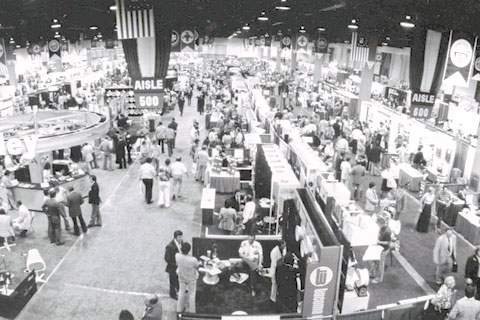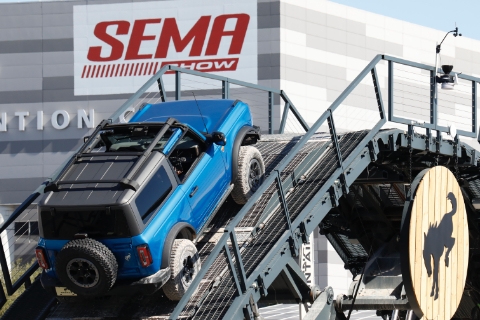SEMA News - December 2010
A View of the Coming Year With SEMA’s Council Leaders
No one can predict the future, of course, but experience is a type of barometer. As we move into a new year, we called on the wisdom of some of SEMA’s most seasoned managers—who also happen to be in leadership positions with the association’s councils—to provide their opinions about what’s just down the road. We hope that their thoughts spark a few of your own.
Automotive Restoration Market Organization (ARMO)
 |
|
Most of the ARMO companies that I have spoken to are also seeing modest gains this year and expect to see growth throughout 2011. Although the industry has felt the effects of the down economy over the last 30 months, it has not been as bad as in many of the other industries that depend on disposable income. People in our hobby tend to be very passionate about their cars.
As our market continues to become more and more Internet-based on the retail level, we are seeing dramatic changes in marketing strategies. Traditional print media is still very important in our market, but retail companies are now looking to increase their online presence.
Our largest challenges for the next year will be in dealing with new legislation. However, unlike most businesses, our members have to deal with misguided state and local governments that in many ways try to outlaw old cars. Unfortunately, many lawmakers see old cars as a problem, not understanding how well these cars are maintained and how few miles most are driven.
—Alex Tainsh
Executive Vice President of Parts Unlimited Inc., Chairman-Elect of ARMO
Hot Rod Industry Alliance (HRIA)
 |
|
the elections.
With the major event promoters extending the age limits on vehicles, I think that the traditional street-rod market will slowly fade and musclecars will gradually increase in popularity. Even though later-model cars are just as expensive to build as traditional street rods, the later models are much more comfortable to drive. In addition, Baby Boomers want the cars they had in high school.
The challenges for HRIA companies include products and instruction manuals being copied and infringements on intellectual property rights. We even have current SEMA members that are doing this to other SEMA members. Several companies have voiced concern, and SEMA’s Washington, D.C., office has sent out information to all members on how to handle these situations.
—Dennis Overholser
Executive Vice President of Painless Performance Products, Chairman of HRIA
Truck and Off-Road Alliance (TORA)
 |
|
We’re seeing a lot of social networking on the marketing side. A lot of retailers are actively promoting their businesses with their own pages on Facebook, and they’re using Twitter messaging. Many of our dealers are also using e-mail and other electronic media in their marketing efforts.
One of the challenges for our members is that many of the automakers are producing their own versions of what were traditionally aftermarket products, so TORA manufacturing companies must continue to come up with creative and innovative new products to stay ahead of that curve. However, the most important thing is that more trucks are being sold in 2010 than were being sold in 2009. Since many of our members are dependent upon that new-vehicle business, they should gear up their inventories to separate themselves from the competition and garner those sales.
—George Lathouris
Senior Category Manager, Wheel & Tire Division, Keystone Automotive Operations, Chairman-Elect of TORA
Motorsports Parts Manufacturers Council (MPMC)
 |
|
The use of electronic media is definitely on the rise, while mobile marketing and event marketing seem to be a larger part of shrinking budgets in this down economy. The MPMC’s “Take a Friend to a Race” initiative draws on our responsibility as motorsports manufacturers to help put spectators in the seats and race cars in the pits, so even a hard day’s work interacting with our customers at the racetrack should still put smiles on our faces.
The biggest challenge is maintaining the confidence to invest in new products and new technologies when the general economic outlook is pretty bleak. MPMC-member companies are fortunate in that our end consumers—racers and performance enthusiasts—are passionate about motorsports and will sacrifice in other areas of their lives to satisfy their need for speed.
New products are the key. Manufacturers that are able to engineer and manufacture new, innovative products will thrive regardless of economic conditions. MPMC-member manufacturers know that we need to constantly engage the media to help tell our story and that events such as the Media Trade Conference offer a substantial return on investment.
—Kyle Fickler
Vice President of Sales and Marketing for Weld Racing LLC, Chairman of MPMC
Manufacturers’ Rep Council (MRC)
 |
|
The economy has been a major factor, but it appears that customers have budgeted for this, allowing for some discretionary spending in their budgets. In my opinion, business is trending more upward for 2011. Customers are purchasing cars and seem to be in a mode of keeping them longer and accessorizing them to
their tastes.
Social media is a large part of the process for consumers to make a purchasing decisions and gain knowledge about products or categories. The challenge is to locate and market to so many factions in forums and groups. Electronic media is a challenge because of the time and money it eats up, and it concerns me that we might forget the brick-and-mortar stores where customers still walk in, albeit with much more knowledge about product and price, thanks to electronic media. They still need to be sold and provided a service in person.
One of the more significant trends for the MRC is the need to provide more information and knowledge to our members, ensuring they can keep on the right side of the electronic media curve and not forget the foundation of what a manufacturer’s rep is here to do—grow sales and relationships!
—Wade Cobb
Principal at HAPCO, Chairman of MRC
Professional Restylers Organization (PRO)
 |
|
The outcome of the midterm elections in 2010 may very well be the catalyst to drive consumer confidence and loosen up spending. The economy has not rebounded the way it was expected to, and some “experts” are saying to accept this climate as the “new normal.” I shudder to think we in this industry would accept that. There is enormous collective talent and creative genius in the accessory industry. It is populated primarily with people who don’t accept retreat, shrinking markets and mediocrity. Therefore, I think the biggest challenge we have is to fight the influence of those who want us to believe this is the “new normal.”
Younger customers present new challenges. Restylers need to keep getting more information and more training. The Technical Skills & Training Conference to be held at Wyotech in Blairstown, Pennsylvania, in March 2011 is an outstanding opportunity to network, get new business ideas and get much-needed training.
—Karl Stearns
Owner of KMS Marketing Solutions, Chairman of PRO
SEMA Businesswomen’s Network (SBN)
 |
|
Our world is smaller than we think. Going global is on the rise. The domestic market is fairly saturated with established WDs, jobbers and retailers, but many opportunities are available in overseas markets. Many countries look to the United States as the automotive trendsetter and want our products. Do some research, and seek out companies that have experienced overseas success with their branded products. Ask them for advice or contact a SEMA-member export management company for assistance. After all, “made in the USA” is still a strong and valued feature in overseas markets.
The biggest and strongest buying power in this country is women. Women spend billions on clothes, makeup, personal care products, home accessories and vehicles. They are interested in the styling and upfitting of their vehicles. Harley-Davidson recognized this trend and is actively going after the female market by building motorcycles and products exclusively for women. There is also an increasing number of women in the aftermarket automotive industry, which includes racing. Women are a part of every segment of the business, from hands-on technicians to CEOs. They are, literally and figuratively, changing the face of our industry.
—Compiled by Rose Kawasaki
Vice President of Exports International, Communications Subcommittee Chair for SBN
Street Performance Council (SPC)
 |
|
It is no surprise that the industry’s typical distribution model is changing rapidly due to the Internet. Marketing departments are facing their largest challenges in many years as they evolve to have a balanced plan for all types of advertising mediums. Aftermarket consumers are more diversified in their interests and their information gathering, which complicates a traditional print-only advertising plan.
Having consistent sales, steady cash flow and productive execution of a solid business plan provide the greatest opportunities, as do understanding your product’s consumer and identifying your business’ core strengths. It is so important to know why your consumer chooses your product and to focus your energy on capturing more of those consumers.
—Tracie Nuñez
Chief Executive Officer of Advanced Clutch Technology Inc., Chairman of SPC
Wheel & Tire Council (WTC)
 |
|
WTC members will strike a marketing balance between traditional channels and electronic media. We want to reach our younger customers through their preferred electronic media, but we still want to reach our older customers through traditional channels without inducing e-mail fatigue with all of the forms of electronic announcements and advertisements.
The economy will certainly affect our market. As people hold on to their vehicles a little longer, the appeal to restyle with aftermarket upgrades is more likely to happen. New tires and wheels remain one of the best ways to enhance the appearance and performance of a vehicle.
Price has been one of the main factors in purchasing tires and wheels for some time. Now our segment of the market wants a quality product, too, so we are seeing an increased awareness and demand for tires and wheels that have been properly tested to industry standards and parts that will survive more than a few seasons. People are steering away from cheaper, copy-cat parts and are spending their money on something with better quality.
—Tim Dietz
Account Manager for Standards Testing Laboratories, Chairman of WTC
Young ExecutivesNetwork (YEN)
 |
|
Two other trends stand out. One is that teens are waiting longer to get their drivers’ licenses—sometimes until they are 18 or 19—and they are typically buying fuel-efficient cars. They can’t afford to fuel the performance cars that our industry loves to promote.
We see in our age group that there is a slowing trend in buying new vehicles. We see individuals who have disposable income choosing to hold on to their dollars instead of purchasing a new vehicle. This is certainly driven by the uncertainty of our economy, but it also may help the automotive specialty-equipment market as those older cars need new parts to stay roadworthy or new accessories to stay “cool.”
Choosing the right marketing mix will pose a challenge in 2011. Many companies either completely cut or significantly dropped their marketing budgets during the recession. Now, as the market is starting to look up, the companies that survived are beginning to slowly step out and start to spend more marketing dollars. But they have to make the right decisions about where to put those budgets. One wrong move could cause a significant back-step in a fragile company.
—Gregory Parker
Marketing and Creative Consultant with Martin & Company Advertising, Chairman of YEN








